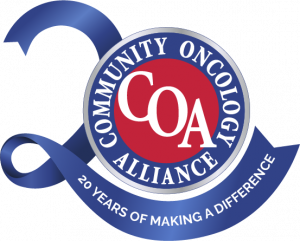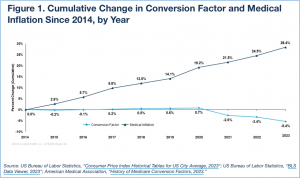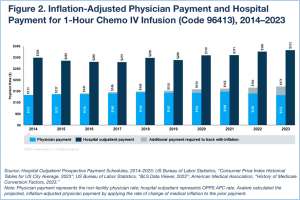Analysis Shows Real Dollar Value of Medicare Physician Payment for High Volume Services Has Decreased While Hospital Payment Increased
WASHINGTON, D.C., UNITED STATES, October 5, 2023 /EINPresswire.com/ — An analysis of physician payments conducted for the Community Oncology Alliance (COA) by Avalere Health examining reimbursement trends finds that payment amounts for high-volume oncology services are generally the same or lower than they were a decade ago. This means the real dollar value of payment for cancer care services at independent, community oncology practices has dwindled due to rate stagnation, cuts, and inflation.
The analysis shows that from 2014 to 2023, the conversion factor in the Medicare physician fee schedule, which is one of the key factors that adjusts reimbursement for independent oncology procedures, has decreased by 5.4 percent, while inflation over the same period increased by a compounded 28.4 percent.
Across infusion codes assessed, physician office payment rates decreased by seven percent, while hospital outpatient rates for these services increased by 27 percent, on average, from 2014 to 2023. Despite a bump in 2021, physician payment for Evaluation and Management codes has also since fallen behind the rate of inflation again. At the same time, hospitals have seen a major increase in reimbursement for the same services.
– Access the full analysis results on the COA website.
For example, in 2023, physician payment for a commonly used chemotherapy administration code is less than it was ten years ago ($133 in 2014 and $132 in 2023), while the hospital rate has increased by 11 percent during the same period. If the chemotherapy infusion reimbursement had kept pace with inflation, it would be $171 in 2023, but that would still represent about half the payment to hospitals ($333). Similarly, physician payment for non-chemotherapy IV infusion declined by almost six percent between 2014 and 2023, while hospital payment increased by about 20 percent over the same period.
To conduct the analysis, Avalere analyzed the year-over-year changes for Current Procedural Terminology (CPT) code reimbursement rates from CY 2014 to 2023. The ten codes analyzed are commonly used by oncologists and other specialists for outpatient care. Year-over-year changes in physician reimbursement rates were compared to reimbursement for those same services in hospitals over the same time period. Across all codes analyzed, the undervaluation of physician practices remained consistent, as did the increase in hospital reimbursement.
This trend of community oncology rate stagnation and cuts, while hospitals are increasingly paid more, has fueled practice closures and consolidation. Additionally, the impact of excessive payments due to bad public policies such as the Medicare Access and CHIP Reauthorization Act (MACRA) and 340B Drug Pricing Program have supercharged these trends. COA has previously noted in its Practice Impact Report that 1,748 community oncology clinics and/or practices have closed, been acquired by hospitals, merged, or reported financial struggles from 2008 to 2020. As community oncology reimbursement has been continually ratcheted down over the last two decades, the chemotherapy services delivered by independent community oncology practices declined by 64.3 percent, presenting serious access concerns for cancer patients. Practice struggles can be directly tied to community oncology practices being reimbursed less and less under the cost of inflation each year by Medicare.
Read the full analysis at https://mycoa.communityoncology.org/education-publications/studies/coa-physician-reimbursement-inflation-avalere-2023-study.
About the Community Oncology Alliance: COA is a non-profit organization dedicated to advocating for community oncology practices and, most importantly, the patients they serve. COA is the only organization dedicated solely to community oncology where the majority of Americans with cancer are treated. The mission of COA is to ensure that patients with cancer receive quality, affordable, and accessible cancer care in their own communities. More than 5,000 people in the United States are diagnosed with cancer every day and deaths from the disease have been steadily declining due to earlier detection, diagnosis, and treatment. Learn more at www.CommunityOncology.org. Follow COA on Twitter at www.twitter.com/oncologyCOA or on Facebook at www.facebook.com/CommunityOncologyAlliance.
Drew Lovejoy
Community Oncology Alliance
[email protected]
![]()
Originally published at https://www.einpresswire.com/article/659888646/analysis-shows-payment-for-key-community-oncology-services-may-lag-inflation-by-at-least-28




